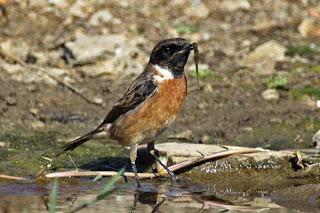As it turned out and in spite of cloudy conditions and a fair amount of rain we had a reasonable morning’s birding. Passerine migrants included several of the expected species such as Spotted & Pied Flycatchers, Northern Wheatears and Chiffchaffs and we also found a single Bonelli’s Warbler. Out over the sea an occasional Balearic Shearwater was seen amongst the numerous Northern Gannets and Cory’s Shearwaters and we might have had further reward had we stayed longer on the cliff top. However, raptors were our priority and during a brief spell when the weather threatened to clear up, we did see a couple of Egyptian Vultures, four Booted Eagles, possibly three different Short-toed Eagles and a Peregrine Falcon over Cabranosa. Raptors elsewhere during the morning were a Black-winged Kite, at least one other Peregrine Falcon, several Common Buzzards and Common Kestrels and a Sparrowhawk.
On the way back we spent a couple of hours at Lagoa dos Salgados where there was an impressive number of gulls, White Storks and Greater Flamingos and a nice selection of waders that included the Pectoral Sandpiper that was first seen on 16th September. A single Glossy Ibis, a Marsh Harrier, one or two Purple Swamp-hens and a Bluethroat were the other highlights. The gulls were mostly Lesser Black-backs but also included at least a couple of Audouin’s.
It was disappointing that we spoke to several people at Salgados who were enthusing about the birds and the lagoon but who, in spite of all the publicity, still had no idea of the threat that the site currently faces or the online petition that has now attracted almost 16,500 signatures.
On Wednesday morning we went a much shorter distance in the opposite direction, east to Castro Marim, still our favourite birding area in the Algarve even though there is no longer public access to a major part of the reserve. It’s hard to pick out highlights among the 60 or so species recorded as none were very surprising but we enjoyed seeing the hundreds of Audouin’s Gulls, a dozen or more Black-necked Grebes, a Peregrine Falcon, a Caspian Tern, about 20 Stone-curlews and a flock of 15 Little Bustards. We were left to wonder what else there might have been in areas that we couldn’t see from the public track.
In the afternoon, we visited a small lagoon close to Castro Marim where three Ferruginous Ducks, eight Red-crested Pochards, a Purple Swamp-hen and a Kingfisher made the short diversion well worthwhile. Later, back in Tavira, it didn’t take more than a few minutes to locate four Slender-billed Gulls, one of which had been colour-ringed in Spain.
Thursday was more or less a day off from birding but around Tavira we did see the hybrid “Grey Egret” and a Slender-billed Gull at Forte do Rato and there were 25 or more Greater Short-toed Larks at two different sites either side of town. Unfortunately, the larks and the Yellow Wagtails with them proved rather skittish and difficult to photograph.
Yesterday we were in the Castro Verde area. It was a mostly cloudy and dull day but it wasn’t until the drive home that there was significant rain. We were able to find several groups of Great Bustards, totalling 20 or more birds but once again Little Bustards eluded us. We saw about 30 or more Black-bellied Sandgrouse, several Tawny Pipits, Calandra Larks and Stone-curlews but, not surprisingly, it was a very poor day for raptors with Common Buzzards sitting dejectedly on power poles and just nine Griffon Vultures and a Black Vulture being of any real note.












































